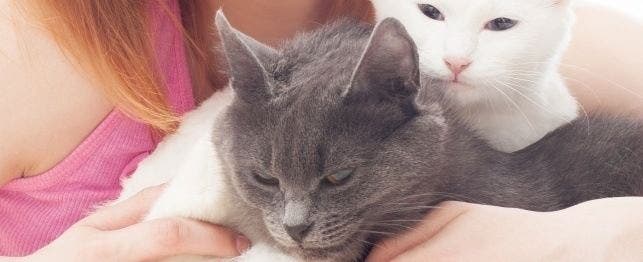
Should I Get Another Cat?
You have a cat companion, but you’re gone all day and think he’s bored and lonely. You think, wouldn’t he like a feline friend. Or, perhaps you just love cats and would like to add another one to your household. Determining whether to add another cat is a complex issue, but one you can solve with a little forethought and planning.
To a degree, cats are independent and naturally self-sufficient. “Cats are quite capable of being an only cat, provided there is enough stimulation and interaction with the owner,” says Kate Gamble, who provides animal behavior consulting through her company, Cat Behavior By Kate in Auburn, Calif. “However, adding a cat to the home can be diverting to a resident cat and help break up the day while the owner is away.”
Unfortunately, your cat can’t tell you if he’d like company, and no barometer exists to take a reading of his preferences. “There is really no test to know if your cat would like another cat,” says Gamble. “If you are gone a great deal and your cat seems very needy, bored or unhappy, another cat might be just the ticket to perk up your resident cat.”
A bored cat may be lethargic and prone to obsessive/compulsive behavior such as pulling out his hair or self-mutilation such as biting his tail. His appetite may be poor, and he may sleep more than normal. Conversely, he may climb your curtains, attack your ankles for attention when you come home or overindulge at meal times. If your cat exhibits any of these symptoms, have him checked by a veterinarian first to determine that nothing is medically wrong before assuming he needs company.
Mix and Match
The younger your cat is, the more easily he will adapt to a new feline companion. In fact, kittens adjust more easily to the addition of a second cat than adults. If you’re just getting your first cat, think about getting two littermates at the same time to ensure the most successful arrangement.
Provided the cats are neutered, any combination of sexes should work, although some behaviorists feel that pairing two cats of the opposite sex is more promising than two of the same sex.
Try to match the newcomer’s disposition with that of your resident cat. “A second feline should be similar in terms of energy level and personality type,” says Gamble. “It would be disastrous to add a high energy cat to a home with a shy, quiet resident cat and vice versa.”
If you have a purebred cat, adopt another cat whose temperament is similar. For example, a laid-back Himalayan might appreciate the easy-going temperament of a Manx or British shorthair rather than the spirited antics of a Siamese or Abyssinian.
If you are adopting from a shelter, ask the staff if they know the background of any cat that interest you. Previously owned cats may have come from homes that had other pets. Shelters that keep cats in communal areas rather than in separate cages will have adoptable cats accustomed to living with other felines. Observe their interactions and try to find one with a personality similar to your resident cat.
Practical Considerations
Besides what your cat may want, you must consider the financial and spatial resources required to care for a second cat. A new cat will require medical care, food, an extra litter box or two and extra litter. You may be able to save money by obtaining a multi-pet discount from your veterinarian or by buying economy sizes of products. And, you may not have to warm up the wet food left over in the can because your resident cat can’t eat it all in one sitting. If you live in a small apartment, you will need to make use of vertical space to give both cats room to move around and get away from one another if the need arises.
Before allowing another cat to meet your resident, have her tested to make sure she has no contagious diseases.
Making It Work
If you do get a second cat, you will have a better chance of the relationship working if you introduce the cats slowly. “Take time for them to get used to each other in separate rooms for a week or two, then brief face to face encounters,” says Gamble. “Slow introductions are much less stressful on both cats.”